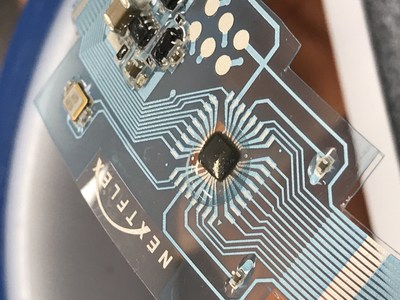Completed NextFlex Project Offers Prime Opportunity to Broaden Awareness of FHE by Capitalizing on Arduino's Popularity with Open-source Developer Community
SAN JOSE, Calif., Feb. 12, 2018 — (PRNewswire) — NextFlex®, America's Flexible Hybrid Electronics (FHE) Manufacturing Institute, today announced it has successfully proven the robustness of the FHE manufacturing process, producing multiple functional samples of a flexible Arduino® system. As part of the Flexible Arduino Microcontroller Project, NextFlex redesigned a device typically built on a rigid printed circuit board (PCB)—by printing and attaching thin bare die on a flexible substrate while maintaining the performance associated with traditional packaged ICs. This achievement ultimately helps realize FHE's enormous potential for creating ubiquitous IoT and sensor products for consumer, commercial and military applications.
Arduino is an open-source, microcontroller-based electronics prototyping platform that utilizes versatile, easy-to-use hardware and software. As a result, Arduino has achieved a high degree of popularity with developers ranging from novices to seasoned experts because it is open source, with publicly available design files and bills of materials (BOMs), and low cost. Up until now, however, Arduino products have been built with traditional packaged die microcontrollers, which deliver high performance and functionality, but have design limitations (fragile, rigid, bulky), therefore complicating integration into newer sensor devices that may be flexible or curved in design.
NextFlex tackled this design challenge head on by developing a process flow for manufacturing a flexible Arduino that reduced the number of process steps by almost two thirds when compared with traditional electronics manufacturing processes. NextFlex replaced the traditional circuit board with a thin, flexible plastic sheet and used digital printing processes for circuit elements. Die attach of a thin bare die eliminated traditional microcontroller packaging while further enabling flexibility of the product. The new process translates to an anticipated savings in manufacturing time and cost, as well as a significant reduction in the end-product weight – the flexible Arduino is only a third of the weight of the rigid Arduino Mini board.
The NextFlex Arduino project's sponsor is the United States Air Force Research Laboratory (AFRL); see announcement here. "The possibilities for FHE technology are virtually limitless," said Dr. Benjamin Leever, the AFRL Advanced Development Team leader and NextFlex Government Chief Technology Officer. "Proving the manufacturability of this technology through an open-source platform will expand FHE's reach even further by providing everyone from industrial product developers to high school students with the opportunity to innovate on new electronics concepts." He added, "We are pleased to have teamed with NextFlex on this project and look forward to the next steps in the optimization process. This is truly a momentous achievement for the FHE community."
Today's announcement further underscores NextFlex's mission to facilitate innovation through collaboration and promote sustainable manufacturing ecosystems. Noted NextFlex Director of Technology Jason Marsh, "Today's breakthrough would not have been made possible without the tireless efforts, passion and teamwork among the NextFlex and AFRL teams. Being able to demonstrate the process manufacturability of a low-cost, easy-to-deploy and truly flexible platform gives everyone—and by that, I mean EVERYONE that feeds into the Arduino open source developer community—the ability to create and speed to market innovative new products that harness the power of FHE."
NextFlex's San Jose-based open-innovation Technology Hub proved valuable in allowing NextFlex to integrate all the component steps to yield functioning samples. The Hub is the only single-source FHE processing production line in the U.S., and offers members access to state-of-the-art production equipment for proving new technology, developing new manufacturing processes, and testing new materials. NextFlex first demonstrated a sample flexible Arduino system last September during its annual Innovation Day, where Wilfried Bair, senior engineering manager for device integration and packaging at NextFlex, talked about the creation of the flexible Arduino. See here at: https://youtu.be/XC09hOloGDo
At this week's 2018FLEX Conference, which runs today through Thursday, February 15, in Monterey, Calif., NextFlex will demonstrate a working Arduino prototype in its booth #1001, and will also show an Arduino board plugged into a tester. According to NextFlex, the next stage will be to optimize each process step for consistent and repeatable process flow, and to conduct reliability testing to ensure the devices meet all usage requirements. To further stimulate interest in the uses for flexible technology, NextFlex CEO Malcolm Thompson will moderate an Applications Panel Discussion during 2018FLEX this afternoon from 4:00-5:30 p.m. More information on the panel can be found at http://www.semi.org/en/2018flex-agenda.
About Flexible Hybrid Electronics
FHE gives everyday products the power of silicon ICs by combining them with new and unique printing processes and new materials. The result: lightweight, low-cost, flexible, conformable, stretchable, and highly efficient smart products with innumerable uses for consumer, commercial and military applications.
About NextFlex
NextFlex®, America's Flexible Hybrid Electronics Manufacturing Institute, is a leading force in the Manufacturing USA network of Institutes. Formed through a cooperative agreement between the US Department of Defense (DoD) and FlexTech Alliance, NextFlex is a consortium of companies, academic institutions, non-profits and state, local and federal governments with a shared goal of advancing U.S. manufacturing of FHE. Since its formation in 2015, NextFlex's elite team of thought leaders, educators, problem solvers, and manufacturers have come together to collectively facilitate innovation, narrow the manufacturing workforce gap, and promote sustainable manufacturing ecosystems. For more information, visit
www.nextflex.us and follow NextFlex on
LinkedIn,
Facebook and
Twitter.
|
Contacts: |
|
|
Marie Labrie |
Karen Savala |
|
MCA |
NextFlex |
|
Phone: 650.968.8900, ext. 119 |
Phone: 408.797.2219 |
|
Email: mlabrie@mcapr.com |
Email: ksavala@nextflex.us |
![]() View original content with multimedia:
http://www.prnewswire.com/news-releases/nextflex-proves-manufacturability-of-flexible-hybrid-electronics-process-creating-first-flexible-arduino-system-ideal-for-bringing-new-iotsensor-products-to-market-fruition-300596820.html
View original content with multimedia:
http://www.prnewswire.com/news-releases/nextflex-proves-manufacturability-of-flexible-hybrid-electronics-process-creating-first-flexible-arduino-system-ideal-for-bringing-new-iotsensor-products-to-market-fruition-300596820.html
SOURCE NextFlex
| Contact: |
| Company Name: NextFlex
|









